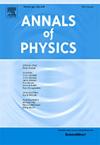Understanding curvature–matter interaction in viable f(R) dark energy models: A dynamical analysis approach
IF 3
3区 物理与天体物理
Q2 PHYSICS, MULTIDISCIPLINARY
引用次数: 0
Abstract
We employ a linear stability analysis approach to explore the dynamics of matter and curvature-driven dark energy interactions within the framework of two types of viable gravity models. The interaction is modeled via a source term in the continuity equations, . Our results reveal significant modifications to the fixed points and their stability criteria compared to traditional gravity analyses without matter–curvature coupling. We identify constraints on model and coupling parameters necessary for critical point stability, illustrating how the interaction influences cosmic dynamics within specific parameter ranges. The findings are consistent with observed cosmic evolution, supporting stable late-time acceleration. Moreover, we highlight the coupling parameter’s potential role in addressing the cosmic coincidence problem.
理解可行的f(R)暗能量模型中的曲率-物质相互作用:一种动力学分析方法
我们采用线性稳定性分析方法在两种可行的f(R)引力模型框架内探索物质和曲率驱动的暗能量相互作用的动力学。通过连续性方程中的源项Q=αρ ω m(3h3 - κ2ρ曲线+κ23 ρ曲线)来模拟相互作用。我们的结果表明,与没有物质-曲率耦合的传统f(R)重力分析相比,固定点及其稳定性标准有了重大修改。我们确定了临界点稳定性所需的模型和耦合参数的约束,说明了相互作用如何在特定参数范围内影响宇宙动力学。这些发现与观测到的宇宙演化一致,支持稳定的后期加速。此外,我们强调了耦合参数在解决宇宙巧合问题中的潜在作用。
本文章由计算机程序翻译,如有差异,请以英文原文为准。
求助全文
约1分钟内获得全文
求助全文
来源期刊

Annals of Physics
物理-物理:综合
CiteScore
5.30
自引率
3.30%
发文量
211
审稿时长
47 days
期刊介绍:
Annals of Physics presents original work in all areas of basic theoretic physics research. Ideas are developed and fully explored, and thorough treatment is given to first principles and ultimate applications. Annals of Physics emphasizes clarity and intelligibility in the articles it publishes, thus making them as accessible as possible. Readers familiar with recent developments in the field are provided with sufficient detail and background to follow the arguments and understand their significance.
The Editors of the journal cover all fields of theoretical physics. Articles published in the journal are typically longer than 20 pages.
 求助内容:
求助内容: 应助结果提醒方式:
应助结果提醒方式:


